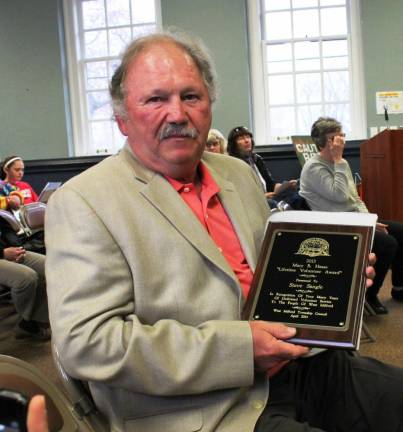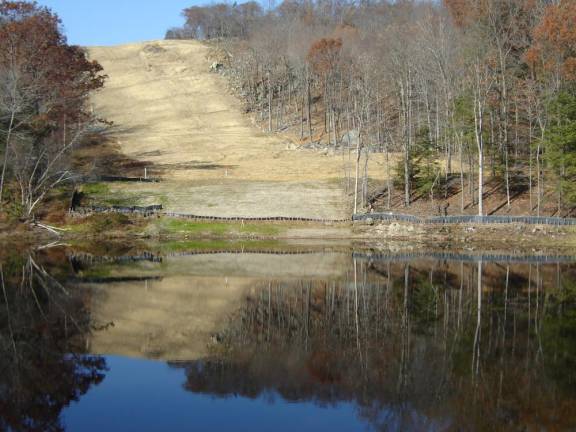Despite bad news, West Milford Environmental Commission will push to meet goals


The Land Conservancy of New Jersey plan to help West Milford do a feasibility study for a Greenway and Trails will not happen. This was one of two disappointments that the West Milford Environmental Commission heard at their meeting earlier this month.
The other discouraging news was that too many trees, planted through a restoration grant, have died. Until that grant is completed and accepted by the New Jersey Department of Environmental Protection the township is not eligible for any more of their grants.
“It was very disappointing to receive a call from Barbara Davis of the Land Conservancy saying that, due to the conservancy’s overwhelming schedule and lack of staff, they are not able to do the feasibility study as previously planned,” said EC Chair Steve Sangle. “I do understand the situation, and we are going to try to seek bids from prospective companies, with the township’s approval, to complete the feasibility study.”
A “greenway” is a strip of undeveloped land near a developed area that is set aside for recreational use and environmental protection. Greenways connect people and places. Each is unique and reflects the character of the community it connects.
“We do not want to ask the town to purchase any parcel that is paying substantial taxes in order to complete any trail that would involve taking funds from the township tax base,” Sangle said. “We’re thinking about easements and or going onto the sidewalks to complete trails where purchasing a property or gaining an easement is not feasible.”
Mayor Michele Dale honored Sangle’s request to appoint a subcommittee to investigate all possibilities. At the latest Township Council meeting, Dale made the appointments. Serving on it with Sangle are Planning Board Chair Chris Garcia, Don Weise and Jim Lyons, a new member of the Environmental Commission. As they move forward, if additional members of the subcommittee are needed, Sangle said he would ask for the approval of the mayor and council to add them from the Environmental Commission or other commissions and boards.
This group, Sangle said, will also look into the completion of the No Net Loss NJDEP grant that the township was awarded. The trees were planted by a contractor, and the NJDEP required a 95 percent survival rate. Sangle said that, currently, 56 trees needed to reach that number have died. Others were reportedly cut down by an outside contractor hired to do mowing.
Township Administrator William Sernande will pursue getting bids for 56 new trees to be planted by the West Milford Department of Public Works employees in the spring, Sangle said. In minutes of the EC meeting on October 4, 2021, there was reference to a report and summary detailing the conditions of the surviving trees and lack of maintenance on trees that were planted in highly visible places. Recommendations included engaging services of a certified forester, periodic inspections of the trees, weed and insect control and pruning.
It was noted in those minutes that the township could choose the sites where they wanted to plant the trees, and the commissioners said that planting the trees in more visible areas would make sense, since they would be more visible and easier to maintain. The NJDEP needs to approve whatever the township decides to do about the additional tree plantings.
In September 2013, the Township Council authorized a grant agreement with the NJDEP acknowledging that $620,197 was available to West Milford for purchasing and planting trees on public lands in the township. The funds were given to the state by the Tennessee Gas Pipeline Company. In November 2017, a site visit from the NJDEP did not go well. Discrepancies were found between the location of the new trees and maps showing the plantings.
At that time, Sangle created an Environmental Commission subcommittee to do a walk through to observe all the trees planted for the NNL grant, and they substantiated the state’s observation that there was an insufficient number of surviving trees to meet the grant requirements. The subcommittee drafted a recommendation, which Sangle forwarded to the administrator, suggesting what species of trees should be purchased and locations where the 56 trees to meet grant requirements should be planted.
The grant was issued by the Tennessee Gas Pipeline Company in accord with New Jersey’s No Net Loss Reforestation Act that required the pipeline company to replace trees removed during the 300 natural gas pipeline project. EC meeting minutes said that several thousand trees were removed by the pipeline project and were being replaced.
Forester Ron Farr, in April 2013, took an assignment to prepare a Community Forest Management Plan for the township. The plan, half of which was funded by a $3,000 Green Communities NJDEP Grant, was a requirement before the larger grant was approved. Because the 6.7-mile pipeline path through the township must be kept clear for maintenance, the trees were planted at other locations within the township on public property.